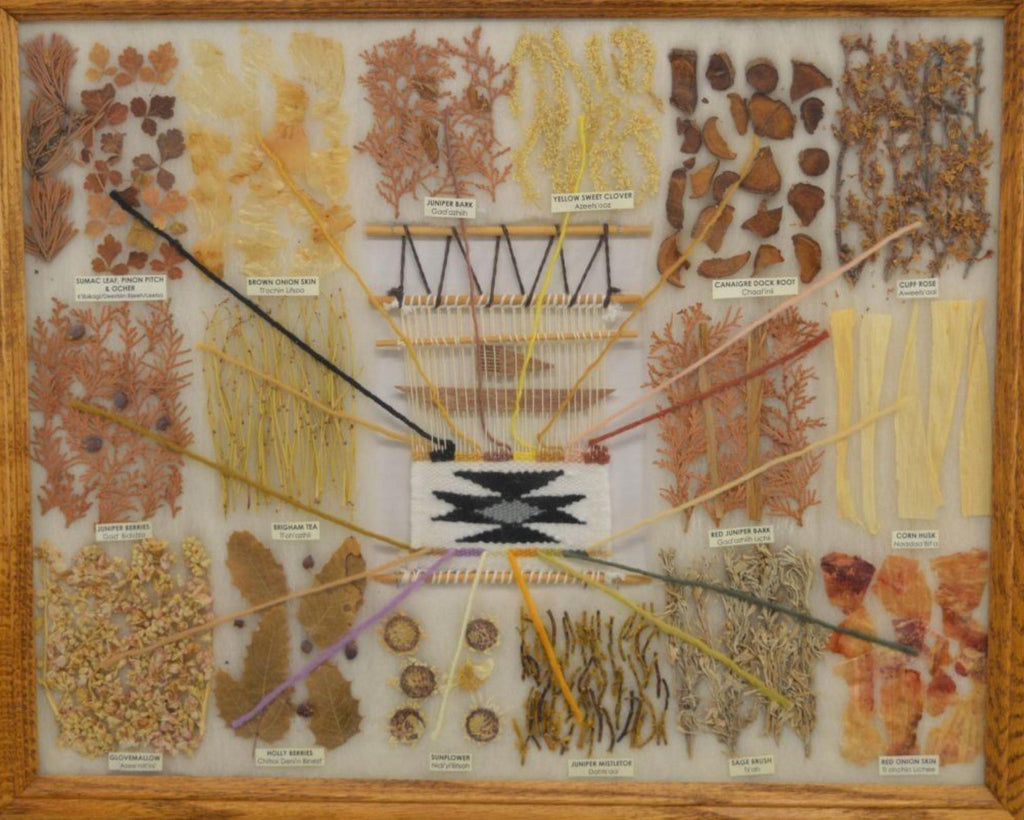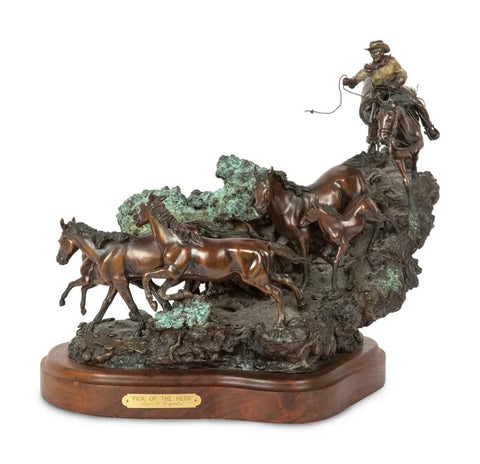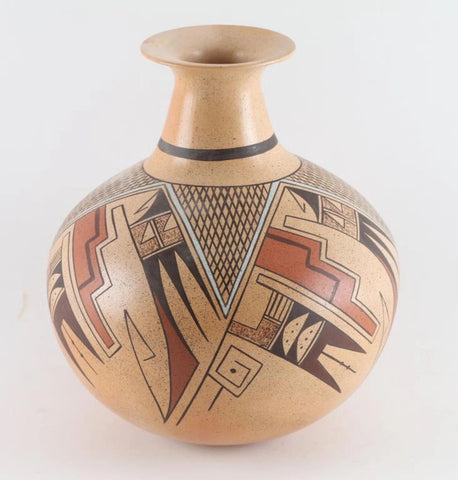
Vintage Native American Navajo Wool Dye Chart, Ca 1980's-1990's, #1579 SOLD
$ 1,000.00
Vintage Native American Navajo Wool Dye Chart, Ca 1980's-1990's, #1579
Description: #1579 Vintage Native American Navajo Wool Dye Chart, Ca 1980's-1990's, by Roslyn Washburn. A Navajo Indian dye chart with samples of natural dye with sample weaving on loom.
Dimensions: Sight 19" x 15" framed to 22" x 18"
Condition: Excellent for age.
Some background on the use and types of dyes used in Navajo rugs:
WEAVING PREPARATION AND TECHNIQUES
"Traditionally the Navajo loom was set up between two young trees or sturdy posts were secured in holes. A lower and upper beam was attached to these side supports. A smooth straight stick or dowel was suspended from the upper beam while another was lashed to the lower beam. Since the upper bar is adjustable it can be use to adjust the tension. The warp thread was strung back and forth in a figure 8 between these two inner sticks or beams. Modern day Navajo looms are made from frames rather than logs and saplings so many are portable. Others are attached to door'frames or to the ceiling and floor.
Although some Navajo men weave, traditionally it has been the Navajo women who have been responsible for weaving from caring for the sheep to the final weaving of the wool yarns. Today many weavers buy their yarn for weaving though there is a trend to going back to the old ways. Some are raising improved breeds of sheep then sending the wool to be commercially produced into yarn. The dying may or may not be done commercially.
There were only a few dyes used in the early Navajo blankets. Indigo dye was used some but was expensive and hard to make into a usable form. Natural yellow dyes were produced from the flowers of rabbit brush. Occasionally indigo and yellow dye was combined to make green dye.
Although the cochineal beetle was used to make red dye in the southwest for unknown reasons this capability was not known to the Navajo. Because red dye wasn't available to the them until the late 1800's weavers unraveled red yarns from pre-dyed trade cloth to use in their weaving.
In the late 19th century, synthetic dyes became available at the trading posts. Initially they tended to fade but later better quality dyes became available. The availability of these dyes encourages the Navajo to experiment with more varying colors. Synthetic dyes continue to be used in some Navajo weaving.
In the first half of the 1900's traders began to encourage weavers to use plant based dyes again. The theory behind this was that Anglo-Americans would be more interested in rugs made with natural dyes. They also resulted in a softer look than is seen with the harsher synthetic dyes. This revival of use of vegetable dye was far different from early yarn dying. An effort was made to find a multiple plant sources resulting in a wide variety colors that are now used in Navajo rugs. Over 200 vegetal dyes are used today from a great variety of native plant sources including walnut hulls, rose hips, alder bark, onion skin, and many more. Leaves, stems, flowers, berries, roots and nuts were all considered possibilities for dye.
We cannot be certain when the first Pueblo weaver taught a Navajo to weave. We know some Pueblo people fled to hide with the Navajo when the Spanish were attacking the Pueblo villages during the 16th and 17th centuries. The mixing of the two cultures included sharing of weaving techniques. Pueblo people used a plain basket type weave, one over and one under with equal both warp and weft threads showing on each side. They continue to use it this plain weave today in making their ceremonial garments.
Over the years the Navajo developed a tapestry weave which has been their dominant weaving technique for over 200 years. In this form of weaving the weft is loosely placed then packed down tightly with the fork resulting in a textile in which the warp is not visible. The fork functions like a weaving comb but has a long handle. The fineness of the weave can vary dramatically from course to extremely fine. The weaving is done in sections measured by the weavers reach. This means the color of the yarn used must be changed frequently. On a large rug you might be able to discern where the weaver ended each section." (Source: Navajo Weaving: Yesterday and Today
by Judy Breneman)
Description: #1579 Vintage Native American Navajo Wool Dye Chart, Ca 1980's-1990's, by Roslyn Washburn. A Navajo Indian dye chart with samples of natural dye with sample weaving on loom.
Dimensions: Sight 19" x 15" framed to 22" x 18"
Condition: Excellent for age.
Some background on the use and types of dyes used in Navajo rugs:
WEAVING PREPARATION AND TECHNIQUES
"Traditionally the Navajo loom was set up between two young trees or sturdy posts were secured in holes. A lower and upper beam was attached to these side supports. A smooth straight stick or dowel was suspended from the upper beam while another was lashed to the lower beam. Since the upper bar is adjustable it can be use to adjust the tension. The warp thread was strung back and forth in a figure 8 between these two inner sticks or beams. Modern day Navajo looms are made from frames rather than logs and saplings so many are portable. Others are attached to door'frames or to the ceiling and floor.
Although some Navajo men weave, traditionally it has been the Navajo women who have been responsible for weaving from caring for the sheep to the final weaving of the wool yarns. Today many weavers buy their yarn for weaving though there is a trend to going back to the old ways. Some are raising improved breeds of sheep then sending the wool to be commercially produced into yarn. The dying may or may not be done commercially.
There were only a few dyes used in the early Navajo blankets. Indigo dye was used some but was expensive and hard to make into a usable form. Natural yellow dyes were produced from the flowers of rabbit brush. Occasionally indigo and yellow dye was combined to make green dye.
Although the cochineal beetle was used to make red dye in the southwest for unknown reasons this capability was not known to the Navajo. Because red dye wasn't available to the them until the late 1800's weavers unraveled red yarns from pre-dyed trade cloth to use in their weaving.
In the late 19th century, synthetic dyes became available at the trading posts. Initially they tended to fade but later better quality dyes became available. The availability of these dyes encourages the Navajo to experiment with more varying colors. Synthetic dyes continue to be used in some Navajo weaving.
In the first half of the 1900's traders began to encourage weavers to use plant based dyes again. The theory behind this was that Anglo-Americans would be more interested in rugs made with natural dyes. They also resulted in a softer look than is seen with the harsher synthetic dyes. This revival of use of vegetable dye was far different from early yarn dying. An effort was made to find a multiple plant sources resulting in a wide variety colors that are now used in Navajo rugs. Over 200 vegetal dyes are used today from a great variety of native plant sources including walnut hulls, rose hips, alder bark, onion skin, and many more. Leaves, stems, flowers, berries, roots and nuts were all considered possibilities for dye.
We cannot be certain when the first Pueblo weaver taught a Navajo to weave. We know some Pueblo people fled to hide with the Navajo when the Spanish were attacking the Pueblo villages during the 16th and 17th centuries. The mixing of the two cultures included sharing of weaving techniques. Pueblo people used a plain basket type weave, one over and one under with equal both warp and weft threads showing on each side. They continue to use it this plain weave today in making their ceremonial garments.
Over the years the Navajo developed a tapestry weave which has been their dominant weaving technique for over 200 years. In this form of weaving the weft is loosely placed then packed down tightly with the fork resulting in a textile in which the warp is not visible. The fork functions like a weaving comb but has a long handle. The fineness of the weave can vary dramatically from course to extremely fine. The weaving is done in sections measured by the weavers reach. This means the color of the yarn used must be changed frequently. On a large rug you might be able to discern where the weaver ended each section." (Source: Navajo Weaving: Yesterday and Today
by Judy Breneman)
Related Products
Sold out












